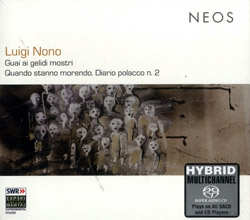
Although less well-known than other members of the Darmstadt school of 20th century composers (e.g. Stockhausen and Boulez), Luigi Nono forged a unique musical voice and was an inventive source of post-modern compositional ideas. This double CD from NEOS Music is an outstanding document of pieces from one of Nono's most groundbreaking periods.
Nono first established a reputation in post-WWII European composition as part of the Schoenbergian lineage, with its adherence to strict compositional rules, but throughout his career he showed a penchant for experimenting with forms and generally testing boundaries. Nono drew heavily from and incorporated into his pieces his wide interests in visual arts, philosophy, and especially politics.
Nono's final decade, the 1980's, saw the maturation of his inclination toward experimentation, and this package features two pieces from that period: "Guai ai gelidi mostri" (Woe betide to cold monsters) and "Quando stanno morendo. Diario polacco n.2." Both pieces are for small vocal/instrumental ensembles, and these performances were recorded in January 2007.
While the pieces are the result of fascinating experiments in compositional form and incorporate the words of great philosophers and writers, it is entirely possible to appreciate them purely on their sonic merits. For example, the text for "Mostri" was compiled by postmodern philosopher Massimo Cacciari and consists of quotes from Nietzsche, Pound, Ovid, Rilke, etc., but content of these sources is hidden by the abstraction of the composition. Nono's style is to have the vocalists sing fragments of the texts--bits often as small as single syllables — as long, unwavering vocal tones. The auditory result is far closer to purely instrumental music than such text-dependent works as opera.
Whatever their extra-musical connections, both pieces are haunting and compelling works. With its pin-drop beginning, "Mostri" practically creeps out of a closet and into the listener's consciousness. The bowed instruments whisper and scrape, duetting with silence. The vocalists fade into the mix almost as hesitantly, emitting their long, pure rays of sound, seeming at times to be pushed to the limits of their ranges and lung capacities.
According to the excellent liner notes for the CDs, Nono used some aleatoric procedures in choosing the duration and timing of the notes, as well as in selecting the fragments of his own earlier compositions from which the music of "Mostri" is drawn. However, the evolving clouds of varying timbral density connote something more like a relaxed Gyorgy Ligeti than, say, a John Cage.
Likewise, while the instrumental parts of "Quando" are partly improvised by the players, they bear stylistic similarity to composed ones in "Mostri," with their emphasis on long tones and use of extremes of volume in attacking the stringed instruments. "Quando" also features live electronic manipulation of the vocal and instrumental performances, according to the liner notes, but whatever this "intrusion" of the mechanical amounts to, it is seamlessly integrated into the performance.
Musically, "Quando" is as unique as "Mostri." However, it is less evocative of other 20th century composers than of some indigenous music. Among the pairing of low-register blasts with monotone recitation there are strains of Tibetan chant; and occasionally its unaccompanied female harmonies remind one of Bulgarian vocal music. However, these comparisons are merely passing associations in a sui generis sonic space that constantly transmogrifies and captivates.
Luigi Nono was experimenting with both musical form and performance, and these pieces were intended to be performed with amplification of the players randomly placed throughout the audience. While a recording cannot capture the full experience of his works, the impeccable performances captured on these clear, well-produced CDs provide an excellent realization of Nono's genius.
Comments and Feedback:
| 


